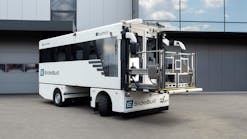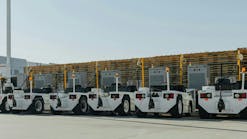Autonomous vehicles are no longer a futuristic concept. They are here and are proving very valuable across diverse industry operations. Regular use of such vehicles in airport ground operations is just a matter of time – and most likely it will be sooner rather than later. That is not to say there are not any challenges.
The need for more universal communications standards and more reliable transmission technologies to support telematics, as well as roadway considerations are among these challenges. Still, there remains great potential for driving improved ground support operations and related benefits by using autonomous vehicles.
Understanding the current state of autonomous vehicle technologies and how they will further optimize ground support operations is important for airline, airport and ground handling professionals.
Optimization Software Helping to Steer Autonomous Vehicles
At the core of successful autonomous vehicles will be advanced optimization software to support operations ranging from autonomous baggage handling to docking of jetways, steering passenger and cabin crew buses and fueling trucks.
Optimization software will be instrumental in terms of optimizing staff and ground support equipment (GSE) in the management of both aircraft and passengers. Leveraging this software, which incorporates artificial intelligence (AI), machine learning and proprietary algorithms, we will start seeing staff and autonomous GSE performing many of the same tasks.
This becomes increasingly more valuable as labor shortages, due to low paying work and the physical demands of these tasks, continue to grow.
Optimization software-driven autonomous vehicles will also prove an asset in mitigating safety problems stemming from human error and carelessness. Another advantage of autonomous vehicles in certain applications is that, unlike humans who require certain qualifications and regular practice for performing certain functions, autonomous vehicles do not. Further, they are available on a 24/7/365 basis with the only exception being when they are being maintained and/or having their batteries replaced.
There is still a way to go to gain the full value of autonomous vehicles, which will require industry collaboration and greater strides in meeting various technology and infrastructure needs.
The Work to Be Done
While telematics used for autonomous GSE will help to ensure a heightened level of data transparency and situational awareness (e.g., providing the estimated arrival time for wheelchair passengers to a connecting gate, or for tail-to-tail rides of transfer luggage), there remain hurdles to overcome to achieve this outcome.
For instance, while some software solutions are relatively independent of hardware and transmission technologies, many are not. In the field of telematics, non-motorized units remain a problem since they require a high transmission quality with low energy. Energy-saving transmission technologies such as LoRa, the physical layer (wireless) modulization that creates the long-range communications link or LoRaWAN, the media access control layer protocol built on top of the LoRa modulization, have not proven to be very reliable in the airport setting where there are many moving aircraft and massive steel structure for GSE and dollies.
What is now preferred for increasing the reliability of information transmission are mesh networks, wherein a wide variety of objects can communicate with each other, bridging long distances and increasing the accuracy of the localization by comparing different position information.
Additional fixed objects at precisely defined positions also can significantly increase accuracy. For example, this enables one to determine the exact position of a catering truck at a loading dock. There still, however, remains the issue of the truck’s GPS signal not being accurate enough, especially when near buildings or under roofs.
Mesh networks, while definitely offering a better solution, remain a challenging option as they can only be achieved with many devices widely distributed over the apron; a setup many find difficult.
Another area that must be addressed in terms of infrastructure is that of creating an environment where both conventional and autonomous vehicles can move safely without disruption.
While numerous production plants have created this environment, the airport setting might require decoupled roadways to be built to accommodate, for instance, bus shuttles or the allocation of luggage from luggage rooms to staging areas.
As the performance and flexibility of autonomous vehicles grows, the need for conventional and autonomous vehicles to share roadways will increase, but eventually will become more seamless.
Autonomous Vehicles and Labor Challenges
Without question, autonomous vehicles can have a major role in both supporting workers and addressing labor-related shortfalls, including those brought on by the COVID-19 pandemic. They can be critical in helping to future-proof GSE operations in the post-pandemic environment.
There is little doubt that autonomous vehicles can effectively perform a wide range of tasks. For example, passengers with reduced mobility can be supported by airport staff as well as autonomous wheelchairs.
Through a disciplined approach to combining both staff and autonomous vehicles, many productivity, safety and passenger experience benefits can be derived. When combined with the latest sensor, 360 camera vision (i.e., for collision detection and avoidance, geo-fencing for operations within approved, white-listed areas, heightened environmental awareness) and light detection and ranging (LiDAR) technologies, the optimum outcomes can be achieved.
Potential accidents on the airfield or within the terminal can be more effectively avoided especially when supported with optimization software, boosted by machine learning, including “Federated Learning” in which part of a GSE fleet learns something new and this knowledge is automatically transferred to other autonomous vehicles.
Bridging the Gap Between Man and Machine
By aligning both human and autonomous vehicle operations, ground support operations can be greatly improved. Driven by advanced technologies, human resources can be optimally managed, communications relating to flight updates such as gate and dispatch of GSE enhanced, and the passenger’s experience made more predictable and seamless.
Through the better utilization of autonomous vehicles/GSE (e.g., baggage handling, pushbacks, GPUs, bobtails, etc.), a reduced dependency on labor and lower transport costs can be achieved. Both safety and security objectives can be better achieved with the broader application of safe autonomous driving shuttle technology.
In the end, the expectations of all constituents – the airlines, the airports, ground handlers and most notably, passengers – will be well-served when autonomous vehicles are more widely and effectively deployed in ground support operations.
Paving the Way for Autonomous Vehicles
According to Allied Market Research, autonomous vehicle technology was estimated at a value of $54 billion in 2019 and is projected to expand ten-fold to $557 billion in 2026. To get there, steps will be needed across key areas of infrastructure, regulations and public-private cooperation.
For airport ground support operations, enhanced communication systems and telematics will be critical. Also needed will be new standards and regulations to support safety concerns, data analysis, record keeping and vehicle testing, among other requirements.
Governments and the aviation industry will need to work together to help ensure the highest standards of operations, maintenance and monitoring of autonomous vehicles in the airport environment prevail.
Michael Reinkober is Product Manager GS RealTime Staff and Equipment at INFORM GmbH, a leading global provider of intelligent optimization solutions for airlines, airports and ground handlers.






